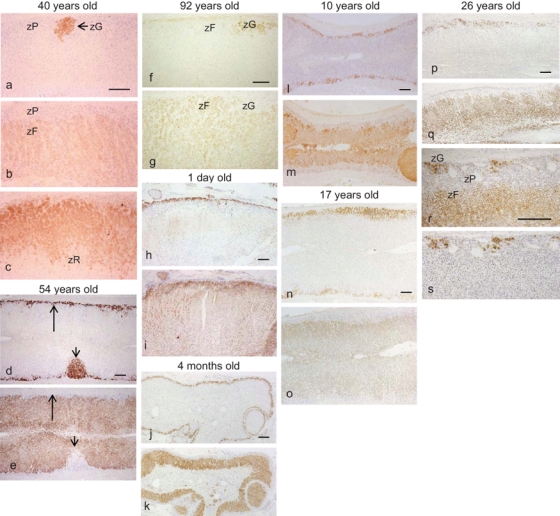Figure 2.

Immunohistochemistry of steroidogenic enzymes according to age: (A) late adulthood (a–g), (B-1) newborns to adolescence (h–o), and (B-2) early adulthood (transitional; p–s). P450aldo (a, d, f, h, j, l, n, p, s), P45011β (b, e, g, i, k, m, o, q), 3βHSD (c), and one-step double immunostaining of P450aldo and P45011β (r). (A) In the adrenals from a 40-year-old patient with renal cell carcinoma (a–c), the great majority of the subcapsular area is replaced by zP cells, which are negative for P450aldo and P45011β but positive for 3βHSD. zG cells occupy less than 25% of the adrenal circumference. The adrenal from a 54-year-old autopsy patient showing secondary aldosteronism and response to severe stress (d, e). Thin-layered zG cells (long arrows) and delta-shaped zG cell clusters (short arrows) may be derived from the zP and the preexisting zG cells, respectively, similar to the findings shown in a–c. Adrenal from a 92-year-old patient with severe stress (f, g). The P450aldo staining pattern is the same as that shown in a, but P45011β immunohistochemistry revealed that the subcapsular cortical zone is replaced by zF cells, except for a few zG clusters due to severe stress. (B-1) ZG/zF zonation is preserved in the adrenals from a newborn (1 day old; h, i), an infant (4 months old; j, k), a preadrenarche subject (10 years old; l, m), and an adolescent subject (17 years old; n, o). (B-2) In the adrenal from a young adult (26 years old), some decrease of the zG with partial replacement by the zP is evident, although the zonal arrangement of the zG is still relatively preserved (p, q). One-step double immunostaining for P450aldo and P45011β reveals that scattered subcapsular immunoreactive cells and lower zonal immunoreactive cells are separated by the immunonegative zonal cells in some areas (r), and staining of serial sections for P450aldo (s) confirms the origin of the cells as being the zG, zF, and zP. zG, zona glomerulosa; zF, zona fasciculata; zP, progenitor zone. Bar = 300 µm.
